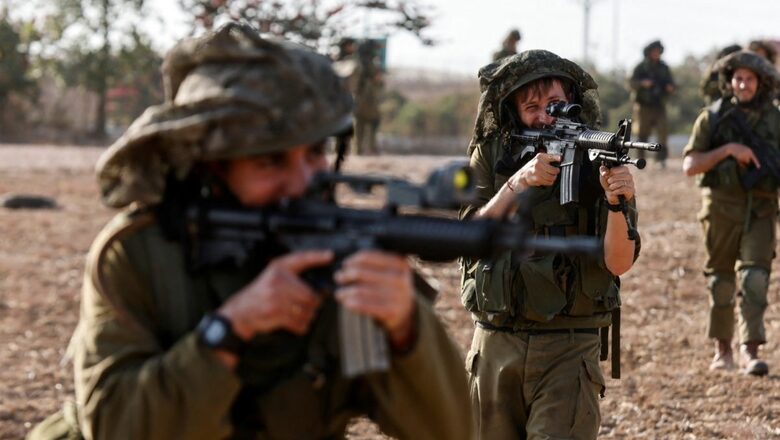
views
After seven days of the Hamas rocket attacks on Southern Israel and Israel’s response using air force, navy and artillery offensive onto Gaza, the casualties on both sides are still mounting. Around 1300 Israelis have been killed and 2800 have been injured. In the Israeli counter bombardment, 1500 Palestinians including 200 children have been killed and nearly 5800 have been injured.
The casualties on the first day amongst Israelis have been colossal and equivalent to the total number of casualties suffered by the country in two wars; namely, the Sinai War of 1956 and the Six Day War of 1966 and there have been half of the casualties suffered in the entire Yom Kippur War of 1973. Israel has warned 1.1 million civilians in northern Gaza to move to the south within 24 hours, which as per the United Nations, is an impossible task.
The impending ground offensive by Israel to crush Hamas leadership and cadres is likely to be multi-dimensional and a very complex operation. The amount of force and strength being used by Israel has to be carefully calibrated to ensure the safety of Israeli prisoners who may be spread in multiple locations, as well as the collateral damage caused to the civilians in Gaza including children and women.
A total siege of the Gaza Strip has been imposed by Israel and electricity, water and food supplies have been cut off. 4,00,00 Palestinians have been rendered internally displaced and another 1.1 million are on the move. Although Israeli Prime Minister Benjamin Netanyahu had warned Palestinians to vacate Gaza, there is no place they can go to unless a safe corridor is ensured into Egypt or mass evacuation from the sea can be undertaken. The question is whether any country would be willing and capable of absorbing such huge numbers of refugees.
Relentless air attacks as per the Palestinian spokesperson have killed 13 hostages including some foreigners. The casualties on the Palestinian side are going to increase manifold in the coming days. A large number of foreigners, mainly tourists from other countries have been killed or wounded in the ongoing clashes. US President Joe Biden has confirmed that 11 US citizens have been killed and some have been taken as prisoners. Thailand has had 18 killed, 14 injured and 11 taken as prisoners. Eight French, seven Argentinians, four Russians, two Ukrainians and two British citizens have been confirmed as killed. South Korea and some other countries have been able to evacuate their citizens safely. There are 18,000 Indians residing in Israel and the Indian government has made arrangements under Operation Ajay to bring home the willing ones.
Prior to the launch of the Israeli ground offensive, its ramifications and the end state in Gaza has to be clearly spelled out by the Israeli political and military leadership. The US has promised $8 billion aid to Israel in the form of sophisticated weapons and command and control equipment. Secretary of State Antony Blinken has reaffirmed never-ending support during his meeting with PM Netanyahu in the Middle East. The EU foreign ministers have decided to continue the financial aid to the Palestinians but are likely to change the methods of delivery to ensure that this money does not go into the hands of Hamas and is not used to further perpetrate violence in the region. Hamas has been declared a banned terrorist group by Israel and the European Union. Israelis have been continuously firing retaliatory artillery rounds toward Lebanon since day two of the conflict and have also engaged Damascus and Aleppo in Syria. The conflict has every chance of spreading in the region.
The ground operation has to be very clearly and painstakingly planned to ensure minimum casualties to the attacking troops and collateral damage to civilians. The urban warfare eats up troops and the operations as witnessed in Grozny, Belarus and Ukraine are slow, difficult and relentless. Hamas has been threatening the execution of hostages if Israel continues to bombard the civilian areas of Gaza without warning. All options have been gone into and Israel has to strengthen its posturing in the North in reply to activation of the Green Line by Hezbollah. Israel feels that Hamas has broken the rules of peace and has to pay the consequences.
Once the ground operations are launched and the Hamas leadership and cadres are taken out, the future status of the Gaza Strip has to be carefully chalked out and implemented. Will Israel allow Jewish settlement in Gaza as was prevalent prior to 2005? Will the Gaza Strip be patrolled and dominated by check posts like the West Bank? The ground offensive will be resisted by civilians and Hamas cadres by ground, air and sea counter-offensives. It may take months, if not years, to clear all the urban neighbourhoods in the Gaza Strip. The number of casualties by the attacker in urban warfare is generally much larger than the other operational areas. Is Israel, as a nation, prepared to take more casualties?
It is unfortunately an asymmetrical war and the answers have to be searched by out-of-the-box solutions. It seems Phase 1 of the ground operations has already started and it was aimed to clear all opposition around the Gaza Strip in Israeli territory. Phase 2 is likely to be launched into Gaza onto the known Hamas localities which are below the ground in the tunnels after creating safe launch pads in the Gaza Strip. The operations have to be small team operations based on hard intelligence. Some amount of collateral damage is bound to take place but any large-scale destruction and killings of innocent civilians are likely to have adverse effects and will turn the international opinion against the Israelis. A graduated response with minimum required force is likely to achieve better results. Phase 3 may be launched to create a buffer zone but that will further accentuate the problem of the density of population in Gaza which already is the third highest in the world. Alongside these three phases, simultaneous special operations to get the hostages released may be carried out.
After the military operations, Israel has three options to deal with Gaza for long-term peace. Option 1 is to follow its time-tested policy of “land for peace” and in the two-nation theory, let a Palestinian state come up in Gaza and the West Bank. This is the most unlikely option acceptable to Israel. Option 2 will be to resettle Jews in Gaza Strip as was the case before 2005. Option 3 is to create a buffer zone and resettle some of the suspected population elsewhere.
It may be recalled that Israel, in pursuit of peace, came up with a “land for peace” theory in the late 70s and signed the Camp David Peace Agreement with Egypt in 1978-79 under the stewardship of the US government. Egypt recognised Israel and in a goodwill gesture, Israel returned the huge landmass of the Sinai Peninsula. In 1993, under the Norwegian and US stewardship, the then Israeli PM Menachem Begin signed the Oslo Peace Accord with Palestine Liberation Organisation (PLO) chief Yasser Arafat and Israel recognised PLO as the sole representative of the Palestinian people. Yasser Arafat promised to renounce terrorism and recognised Israel’s right to exist. The next year, in 1994, Israelis signed a peace treaty with Jordanian King Hussain and returned the occupied areas along the Jordan River to Jordan.
Israelis also offered to return more than 85 per cent of the land mass in Golan Heights to Syria in 1998 but the ailing Hafez al-Assad did not trust the Israelis. Assad later regretted his decision at the time of his death in 2000. The best and only lasting situation is the “two-nation solution” wherein the Palestinians should be given a separate nation consisting of the West Bank and Gaza. Otherwise, the basic issue will remain unresolved and violence will erupt again after a few years. The present Israeli government and the majority of the Jewish population are opposed to the two-nation solution and are postponing a problem for their grandchildren to solve.
The author was Head of the Mission and Force Commander of UN Peacekeeping Mission (UNDOF) between Israel and Syria at Golan Heights from 2012 to 2014. Views expressed in the above piece are personal and solely that of the author. They do not necessarily reflect News18’s views.

















Comments
0 comment